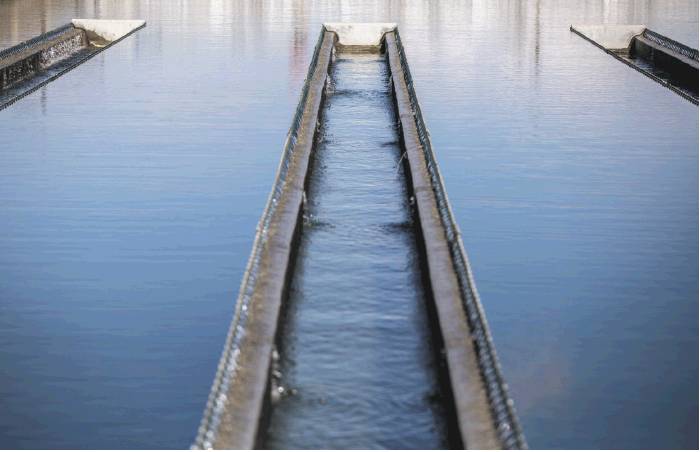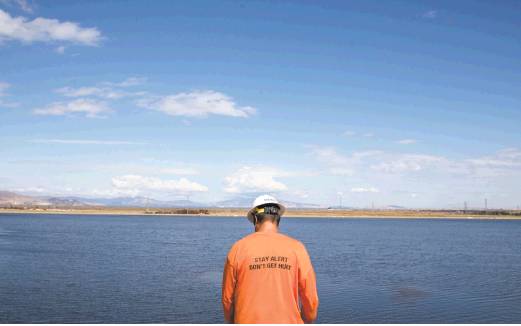Bay Area would get millions for water
$8.9 billion ballot measure aims to fix systems in state
By Kurtis Alexander
The biggest ticket item on California’s November ballot, tucked between the governor’s race and local elections, is $8.9 billion in bonds to help modernize California’s sprawling waterworks.
The measure, which was authored by a former state water director, would fund scores of projects, from shiny new desalination plants to upgrades of old dams and aqueducts to restoration of tainted watersheds, including San Francisco Bay.
The initiative, Proposition 3, comes as a historic drought has exposed the vulnerabilities of California’s water infrastructure, and it has become apparent that hotter, drier times ahead will test the adequacy of state supplies.
Among the proposition’s greatest outlays are $750 million to fix the 150-mile Friant-Kern irrigation canal in the San Joaquin Valley, $200 million for repair work at Oroville Dam and $250 million for yet-to-be-determined improvements to Bay Area water systems.
“We’re in a climate-driven situation now where droughts will be part of our future forever,” said Jerry Meral, former deputy director of the California Department of Water Resources and author of Prop. 3. “We’ve got to make our water supply more reliable, and this is going to help.”
While the numerous projects that would benefit from bond dollars are the measure’s chief selling point, they’re also the concern of critics who see the initiative as a boondoggle.
“There’s some good in here, but there’s too much bad stuff,” said Kathryn Phillips, director of the California chapter of the Sierra Club, which has come out against the proposition. “The money is going to benefit certain interests while it’s not going to benefit people, say, in San Diego or Redding or other places.”
Prop. 3 is among 11 state ballot measures facing voters next month, and it’s the costliest of four that seek to authorize billions in new borrowing.
Still, dozens of farming organizations, environmental groups and social justice advocates have joined with water agencies to support the bonds. They’ve put up nearly $5 million to campaign for the measure — compared to no reported contributions by opponents — and they say the initiative’s many expenditures are a necessary down payment on a more secure future.
Meral traveled extensively across the state to determine what to include in the measure, hearing from farmers who want more water to grow crops, cities looking for ways to survive the next dry spell and small towns seeking money to clean up dirty supplies. The measure reflects a mix of these interests.
No money would go to construction of new dams or the state’s proposed tunnel project in the Sacramento-San Joaquin River Delta, both of which have been controversial, in large part because of their high price tags.
The $250 million for Bay Area water infrastructure could revive a push for a new region-wide desalination plant. The money is earmarked for a group of eight agencies, known as the Bay Area Regional Reliability partnership, which is looking at ways to get more water.
A proposed facility in Contra Costa County, near the delta, that would turn brackish water into drinkable reserves is one of the projects up for consideration. One proposal would put the operation at the site of Contra Costa Water District’s Boll-man Water Treatment Plant.
The partnership is also looking to build new pipelines to link their water supplies, which would be necessary for sharing, whether it’s new desalinated water or other sources.
“Historically, I think the Bay Area water agencies had not been a model of cooperation,” said Steve Ritchie, assistant general manager for water enterprise for the San Francisco Public Utilities Commission. “But with time and with pressure building, these types of interconnections could be very useful.”
The measure also includes $200 million for flood protection in the Bay Area, adding to the $25 million a year that’s already being spent through the region’s voter-approved Measure AA.
The flood money, like much of Prop. 3 funding, would be given out in grants, in this case to those combatting floodwaters through such efforts as restoring wetlands.
“The scientists tell us the sooner we can get tidal marsh (projects) started, the better chance we have of keeping up with sea level rise,” said David Lewis, executive director of Save the Bay and a supporter of the proposition.
Another $100 million from the measure would go to protection of additional Bay Area watersheds.
The initiative also makes provisions for poorer communities in California, giving them priority for competitive funds and guaranteeing at least $750 million of investment in disadvantaged areas.
Prop. 3 comes on the heels of two other water-related ballot measures. In June, voters approved Proposition 68, a $4.1 billion bond that funded water projects as well as parks and land conservation. In 2014, voters approved Proposition 1, which committed $7.5 billion of state borrowing exclusively to water, including new dams and reservoirs.
Since the 1970s, more than a dozen propositions have helped fund water infrastructure. Bonds are commonly used by governments to pay for ventures they can’t immediately afford. They’re basically loans that must be paid back, with interest, and in California, such borrowing requires voter approval.
Unlike the two previous water measures, Prop. 3 was not put on the ballot by the Legislature, but by Meral, who collected the requisite 365,880 signatures to do so.
The Sierra Club argues that the measure is simply not worth the expense and that the private interests funding the campaign, such as agriculture, are the ones that would disproportionately gain.
“It’s a pay-to-play measure,” Phillips said.
Phillips also took issue with how the money would be doled out. She said the many state agencies that would be awarding grants would face sparse oversight.
Little polling has been done on Prop. 3. But with drought and water supplies a well-documented concern of state residents, a survey over the summer by the Public Policy Institute of California indicated strong support.
Kurtis Alexander is a San Francisco Chronicle staff writer. Email: kalexander@sfchronicle.com Twitter: @kurtisalexander

